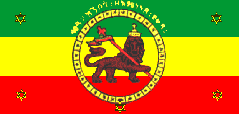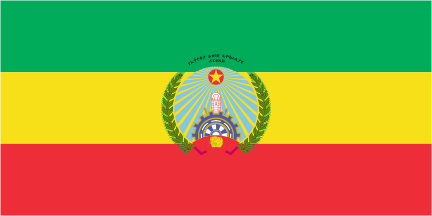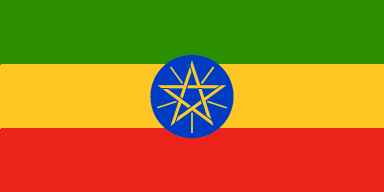Flags and Symbols of Ethiopia

The


 I
I IMPer
IMPer ial F
ial F lag o
lag o f
f  E
E thiopia is
thiopia is the N
the N ational
ational  Tri-color,
Tri-color, Gree
Gree n (
n ( to
to p),
p),  Yellow (middle), and Red (bottom) horizontal
stripes of equal size. At the center is a Gold Lion marching east
carrying a cross and wearing the Imperial Ethiopian crown. This is the
Lion of Judah symbol, which is the symbol of the Emperor of Ethiopia.
This flag has been adopted by the Ras Taffarian movement which is based
on the belief in the divinity of Emperor Haile Selassie, and is widly
used in the Carribean and around the world by Rastas as their own
colors. Many countries around Africa have also adopted the three colors
of the Ethiopian flag for their own flags upon independence, in a show
of African unity and as a mark of honor for the oldest flag in
independent Africa. Each country has positioned the colors in different
positions on their flags and added their own national symbols and
elements.
Below is the Flag of the Empire of Ethiopia as it appeared until
September 1974. The colors of the Ethiopian flag are Green Yellow and
Red in horizontal stripes. They have appeared in different orders
during different reigns, and sometimes white was substituted for yello,
and blue instead of green. Emperor Yohannis IV also used an additional
banner of two red horizontal stripes separated by a yellow stripe. The
Zagwe Emperors are said to have used an image of christ on their
banners. The present order was formaly established in law by Emperor
Menelik II, where the green stripe is always on top. The Lion of Judah,
which is the emblem of the monarch has been in use for centuries in
Ethiopia.
Yellow (middle), and Red (bottom) horizontal
stripes of equal size. At the center is a Gold Lion marching east
carrying a cross and wearing the Imperial Ethiopian crown. This is the
Lion of Judah symbol, which is the symbol of the Emperor of Ethiopia.
This flag has been adopted by the Ras Taffarian movement which is based
on the belief in the divinity of Emperor Haile Selassie, and is widly
used in the Carribean and around the world by Rastas as their own
colors. Many countries around Africa have also adopted the three colors
of the Ethiopian flag for their own flags upon independence, in a show
of African unity and as a mark of honor for the oldest flag in
independent Africa. Each country has positioned the colors in different
positions on their flags and added their own national symbols and
elements.
Below is the Flag of the Empire of Ethiopia as it appeared until
September 1974. The colors of the Ethiopian flag are Green Yellow and
Red in horizontal stripes. They have appeared in different orders
during different reigns, and sometimes white was substituted for yello,
and blue instead of green. Emperor Yohannis IV also used an additional
banner of two red horizontal stripes separated by a yellow stripe. The
Zagwe Emperors are said to have used an image of christ on their
banners. The present order was formaly established in law by Emperor
Menelik II, where the green stripe is always on top. The Lion of Judah,
which is the emblem of the monarch has been in use for centuries in
Ethiopia.


Front of Imperial Standard

Back of Imperial Standard




Weeble |
Teachers Lounge |
Blogmatters |
Useless Facts
Back to Imperial Ethiopia Homepage
0




 I
I IMPer
IMPer ial F
ial F lag o
lag o f
f  E
E thiopia is
thiopia is the N
the N ational
ational  Tri-color,
Tri-color, Gree
Gree n (
n ( to
to p),
p),  Yellow (middle), and Red (bottom) horizontal
stripes of equal size. At the center is a Gold Lion marching east
carrying a cross and wearing the Imperial Ethiopian crown. This is the
Lion of Judah symbol, which is the symbol of the Emperor of Ethiopia.
This flag has been adopted by the Ras Taffarian movement which is based
on the belief in the divinity of Emperor Haile Selassie, and is widly
used in the Carribean and around the world by Rastas as their own
colors. Many countries around Africa have also adopted the three colors
of the Ethiopian flag for their own flags upon independence, in a show
of African unity and as a mark of honor for the oldest flag in
independent Africa. Each country has positioned the colors in different
positions on their flags and added their own national symbols and
elements.
Below is the Flag of the Empire of Ethiopia as it appeared until
September 1974. The colors of the Ethiopian flag are Green Yellow and
Red in horizontal stripes. They have appeared in different orders
during different reigns, and sometimes white was substituted for yello,
and blue instead of green. Emperor Yohannis IV also used an additional
banner of two red horizontal stripes separated by a yellow stripe. The
Zagwe Emperors are said to have used an image of christ on their
banners. The present order was formaly established in law by Emperor
Menelik II, where the green stripe is always on top. The Lion of Judah,
which is the emblem of the monarch has been in use for centuries in
Ethiopia.
Yellow (middle), and Red (bottom) horizontal
stripes of equal size. At the center is a Gold Lion marching east
carrying a cross and wearing the Imperial Ethiopian crown. This is the
Lion of Judah symbol, which is the symbol of the Emperor of Ethiopia.
This flag has been adopted by the Ras Taffarian movement which is based
on the belief in the divinity of Emperor Haile Selassie, and is widly
used in the Carribean and around the world by Rastas as their own
colors. Many countries around Africa have also adopted the three colors
of the Ethiopian flag for their own flags upon independence, in a show
of African unity and as a mark of honor for the oldest flag in
independent Africa. Each country has positioned the colors in different
positions on their flags and added their own national symbols and
elements.
Below is the Flag of the Empire of Ethiopia as it appeared until
September 1974. The colors of the Ethiopian flag are Green Yellow and
Red in horizontal stripes. They have appeared in different orders
during different reigns, and sometimes white was substituted for yello,
and blue instead of green. Emperor Yohannis IV also used an additional
banner of two red horizontal stripes separated by a yellow stripe. The
Zagwe Emperors are said to have used an image of christ on their
banners. The present order was formaly established in law by Emperor
Menelik II, where the green stripe is always on top. The Lion of Judah,
which is the emblem of the monarch has been in use for centuries in
Ethiopia.

The Imperial Standard
is the Ethiopian Flag (horizontal Green, Yellow, and Red stripes)
St. George slaying the Dragon on the front of the flag. Surrounded
with the chain of the Order of Solomon's seal, and the Lion of Judah on
the back. The Ethiopian Star of Solomon (Star of David with a Cross
Centered on it)
would appear on each corner of the standard, front and back. The
Imperial Standard was draped on the coffin of Emperor Haile Selassie,
and can be seen in the pictures of his funeral on the web pages covering
this event linked below in the special Funeral section of this page.
St. George was one of Ethiopia's Patron Saints, and was associated
particularly with the Imperial Family and with the Imperial military
forces as well. The Battle of Adwa in 1896 which resulted in a
resounding victory of Ethiopia over the colonial forces of Italy took
place on the feast day of St. George, and it is this event that inspired
both the construction of Addis Ababa's St. George Cathedral (Kidus
Giorgis) and the placement of this Saint on the Imperial Standard, and
on the Standard of the Imperial Army. A very large mosaic of St. George
was part of the facade of the Parliament building in Addis Ababa, but
it was painted over by the Derg regime following the revolution of 1974,
and it remains painted over today.


Emperor Haile Selassie used a three point star with
three linked rings as a personal emblem. The three point star was
known as the Trinity Star, and symbolized the Holy Trinity for whom the
Emperor was named (his baptismal and regnal name Haile Selassie means
"Power of the Trinity").
During the fascist occupation of Ethiopia between
1936 and 1941, Ethiopia was proclaimed to have been annexed by Italy,
and the King of Italy was declaired "Emperor of Ethiopia" by the
Mussolini regime. Ethiopia was incorporated into the new entity called
"Italian East Africa" or "Africa Orientale Italiana". The Royal Italian
flag, the green white and red tricolor with the arms of the House of
Savoy centered became the flag of the colony.

With the expulsion of the Italians in 1941, and the
restoration of the Emperor Haile Selassie, the Imperial flag was
restored also. The King of Italy renounced his Imperial title over
Ethiopia in November 1943.
In the immediate aftermath of the Ethiopian Revolution of 1974, the
Provisional Military Administrative Council(PMAC) or Derg, removed the
crown from the head of the Lion of Judah and replaced the cross with a
spear, calling this emblem the "Lion of Ethiopia". In the first few
public statements of the millitary junta, lip service was paid to the
preservation of the monarchy, with statements made that the Crown Prince
would be sworn in as "King" rather than Emperor, and the role of the
monarch cut back to a purely symbolic role. This flag was used only
briefly between September 11th, 1974 when the Emperor was deposed, to
November 1974 when the Derg removed the Lion symbol completely from the
flag.

With the formal abolishment of the Monarchy by
proclamation a few months later, the lion was completely removed from
the flag, and the complex Derg emblem began to be displayed in the
middle of the flag as a government banner. (Image of the first Derg era
flag coming soon).
Upon the proclamaiton of the Peoples Democratic
Republic of Ethiopia by the Derg in 1985, a new complicated official
coat of arms was placed at the center of the flag. It depicted the Axum
obelisk surmounted by a five point star on a blue field,with a cog wheel
at the base, flanked by olive branches. Above appear the words in
Ge-ez alphabet, "Hizbawi Democrasiawi Repooblic Ityopia" (Peoples
Democratic Republic of Ethiopia) This can be refered to as the second
Derg era flag.

Upon the fall of the communist regime and the
proclamation of the new Federal Republic in the early 1990's, yet
another emblem featuring a yellow pentagram on a blue circular field has
replace the Lion at the center of the national tricolor flag. This is
the flag presently used by the Federal Republic of Ethiopia.

Emperor Menelik II and Emperor Haile Selassie both
used their monograms as personal emblems. Emperor Menelik used the
ge-ez letter meh (the first letter of his name) surmounted with a crown.
Emperor Haile Selassie usesd the entwined letters Ke Ha and Seh, (for
Kedamawi Haile Selassie, or Haile Selassie the First) sometimes
surmounted with a crown and sometimes without. He was often refered to
as Kehas for short. Emperor Menelik's consort, Empress Taitu's clever
monogram was the letter Ta surrounded by sun rays as her emblem. Her
name Taitu when translated means "the Sun" and she had the additional
honorific title of "Berhan ze Ityopia" or "Light of Ethiopia" so the sun
rays played on those connections.
Emperor Haile Selassie used a three point star with
three linked rings as a personal emblem. The three point star was
known as the Trinity Star, and symbolized the Holy Trinity for whom the
Emperor was named (his baptismal name Haile Selassie means "Power of the
Trinity").
Back to Imperial Ethiopia Homepage